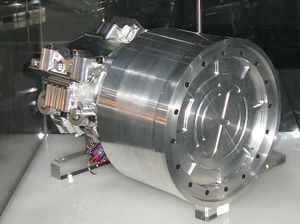Kinetic energy recovery system

Kinetic energy recovery systems (KERS) are systems used in Formula 1 vehicles in order to recover kinetic energy for future use. It works by converting the energy of motion when the car decelerates into electrical energy which is stored in a battery, supercapacitor,[2] or as mechanical energy in a flywheel,[3] and would otherwise be lost as heat.[4] The driver can then press a button on their steering wheel, discharging the battery to motion of the drive shaft and giving their vehicle a boost of power.
KERS uses three main components to do its job: a Motor/Generator Unit (MGU) which converts mechanical energy into electricity and vice versa, a Power Control Unit (PCU) which controls the switching of current between the MGU and the battery, and finally the storage device which can be any of those mentioned above. The KERS uses a "charge cycle" and a "boost cycle", the former occurring upon deceleration in order to store the kinetic energy, and the latter occurring when the driver presses the KERS button.[2]
The battery is allowed to store 400 kilojoules (111 watt-hours) per lap, giving Formula 1 drivers 82 horsepower to use for 6.6 seconds each lap.[3]
Click here to see the operation of a kinetic energy recovery system, and watch the video below to see KERS in action.
References
- ↑ Wikimedia Commons [Online]. Available: http://en.wikipedia.org/wiki/Kinetic_energy_recovery_system#/media/File:Flybrid_Systems_Kinetic_Energy_Recovery_System.jpg
- ↑ 2.0 2.1 Harsh Gupta via slideshare, Kinetic Energy Recovery System (KERS) [Online], Available: http://www.slideshare.net/harshgupta161/kinetic-energy-recovery-system-kers
- ↑ 3.0 3.1 Gizmag, Formula One KERS explained [Online], Available: http://www.gizmag.com/formula-one-kers/11324/
- ↑ Top Gear, Why we need cars with KERS [Online], Available: http://www.topgear.com/uk/car-news/volvo-kers-driven-2014-3-25

